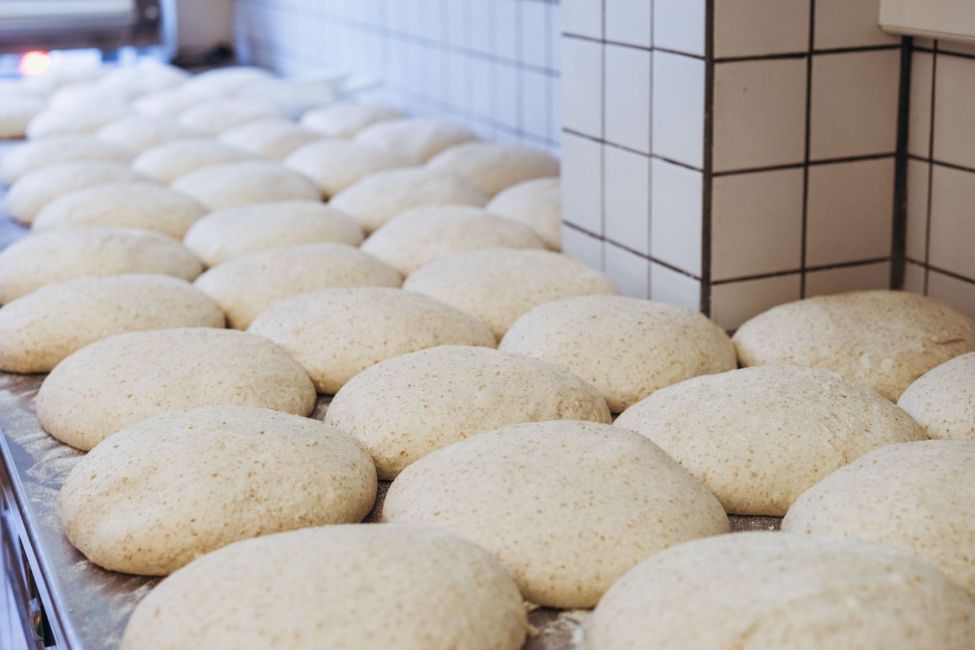Breadmaking is an art that has been practiced for centuries. The process of mixing, kneading, and allowing the dough to rise is crucial in achieving that perfect loaf.
However, there might be times when life gets busy, and you find yourself wondering, what happens if I let bread dough rise too long?
In this article, I’ll reveal the answer to this question, explore the consequences of extended rising time, and provide tips on what should you do if your bread rises too much. Let’s dive in.
What Happens if I Let Bread Dough Rise Too Long – Revealed
If you let your bread dough rise too long, it can have a number of negative effects on the final product. Here are a few things that can happen:
1. Loss of Structure
When bread dough is left to rise for an extended period of time, the gluten structure in the dough begins to break down.
As gluten breaks down, the dough becomes weak and loses its ability to support the weight of the bread. This can cause the bread to collapse and lose its shape, resulting in a dense and flat loaf.
In addition, an over-proofed dough may not rise as much during baking, leading to a smaller loaf with a tighter crumb structure.
The crumb structure refers to the texture and size of the air pockets in the bread. A tightly crumbed bread is denser and has fewer air pockets than bread with a looser crumb structure.
2. Excessively Elastic Dough
When the dough has over-risen, it can become too elastic, resulting in several issues during the baking process.
The dough can be challenging to shape and work with due to its increased elasticity. As a result, it may not retain its shape well during baking, leading to misshapen bread or pastries.
Additionally, the dough may end up with a chewy and tough texture, which can make it less palatable.
The excessive elasticity of over-risen dough is caused by the presence of an excessive amount of gluten, a protein found in flour. Gluten forms a network that gives dough its elasticity and helps it rise.
However, if the dough is left to rise for too long, the gluten network becomes too strong, resulting in a dough that is excessively elastic.
3. Sour Taste
Yeast produces carbon dioxide during fermentation which causes the dough to rise. However, if the dough is left to rise for too long, the yeast continues to ferment and produces more acidic byproducts.
These byproducts, primarily lactic acid, and acetic acid, give the bread a sour or tangy taste.
The sourness in bread is not necessarily a bad thing, as it can be desired in certain types of bread, such as sourdough bread.
Sourdough bread is made by using a sourdough starter, which is a mixture of flour and water that has been fermented for an extended period of time.
The long fermentation time allows for the development of complex flavors and a characteristic sour taste in the bread.
However, if you do not want a sour taste in your bread, it is important to control the rising time of the dough and ensure that the yeast does not continue to ferment for too long.
4. Coarse Texture
When the dough is risen for too long, it can cause the bread to have a coarse and uneven texture.
This happens because the yeast has consumed too much of the sugar and starch in the dough, leaving it with an insufficient amount to rise properly.
The result is large and irregular holes in the bread, making it less desirable.
How to Tell if Bread Dough Has Over-Risen?
There are several signs that can indicate that bread dough has over-risen, Here are five of them.
- Dough has a sour smell: If the dough has been left to rise for too long, it may begin to smell sour or ferment. The sour smell indicates that the yeast has consumed most of the sugars in the dough, and the fermentation process is well advanced. The over-fermented dough will give your bread a sour taste and an unpleasant smell.
- Dough collapses when touched: Over-risen dough may lose its structure and collapse when touched or moved. The dough will not hold its shape, and you will be unable to shape it into a loaf. The bread will come out flat, dense, and unappealing.
- Dough becomes sticky: Over-risen dough loses its elasticity, and the gluten breaks down, causing the dough to become sticky and unworkable. If the dough becomes too sticky and difficult to work with, it may have over-risen.
- Dough develops large air pockets: Over-risen dough may develop large air pockets that can cause uneven baking and texture. These air pockets will cause the bread to rise unevenly, resulting in a loaf that is undercooked in some areas and overcooked in others.
What Should You Do if Your Bread Rises Too Much?
If you realize that your bread dough has over-risen, don’t despair! There are a few things you can do:
1. Punch Down the Dough
When bread dough rises too much, it becomes too light and airy, making it prone to collapsing during baking.
Punching down the dough gently releases some of the built-up air, which helps it maintain its structure and shape.

To do this, you can use your hands to press down on the dough gently or use a dough scraper to push it down. Be careful not to press too hard, or you may damage the dough.
2. Reshape the Dough
Shaping the dough into the desired shape before the second rise can help maintain the bread’s shape and prevent it from over-rising.

This technique is particularly useful if the dough has risen too much during the first rise. Depending on the recipe, you can use a bread pan or a banneton to shape the dough.
A bread pan is suitable for a sandwich loaf or rustic bread, while a banneton is ideal for artisan bread.
3. Reduce the Rising Time
If you find that your bread consistently rises too much, you may need to reduce the rising time.
The ideal rising time can vary depending on the recipe, the temperature, and the humidity. To reduce the rising time, you can try one or more of the following techniques:
- Reduce the amount of yeast used in the recipe
- Reduce the temperature of the rising environment
- Shorten the first rise time
It is important to monitor the dough closely during the rising process and adjust the time as needed to achieve the desired result.
4. Bake Immediately
If you are short on time and cannot adjust the rising time, you can bake the bread immediately.

However, keep in mind that this option may result in a less-than-ideal texture and flavor. Bread dough needs time to ferment and develop its flavor and structure fully.
Baking it immediately may result in a denser loaf that lacks complexity in flavor. If possible, try to plan your baking ahead of time to allow the dough to rise appropriately.
Can Bread Rise Too Long?
Yes, bread can rise too long, and this phenomenon is known as “overproofing.”
Overproofing occurs when the dough ferments for an extended period, leading to excessive carbon dioxide production.
This can result in a range of undesirable outcomes that affect the taste, texture, and overall quality of the bread.
What Happens if I Let Bread Dough Rise Too Long – Conclusion
In conclusion, letting bread dough rise for too long can have negative consequences for the final product. The over-risen dough can lose its structure, become too elastic, develop a sour taste, and have a coarse texture.
However, by monitoring your dough closely and looking out for signs of over-proofing, you can avoid these pitfalls and create a delicious, perfectly risen loaf of bread.
And if your dough does over-rise, don’t panic – there are still ways to salvage it and turn it into a delicious bake.
Frequently Asked Questions
How Long Is Too Long to Let Bread Dough Rise?
The ideal length of time to let bread dough rise can vary depending on the specific recipe, type of bread, and environmental factors like temperature and humidity.
However, as a general guideline, most bread recipes suggest letting the dough rise for about 1 to 2 hours during the first rise (bulk fermentation) and then 30 minutes to 1 hour during the second rise (proofing) after shaping the dough.
Is It OK to Let Bread Dough Rise Longer?
Yes, it’s generally okay to let bread dough rise for a longer period of time, especially if you’re doing so under controlled conditions.
In fact, some bread recipes, like those for artisan or sourdough bread, call for longer fermentation periods to develop complex flavors and improve the texture of the bread.

